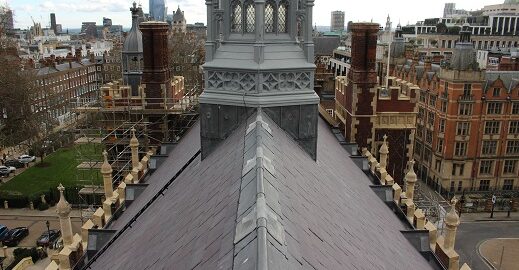12/05/2022
Penrhyn Heather Blue slates from Welsh Slate feature on Lincoln’s Inn’s Great Hall.
One of London’s most unique buildings is enjoying a new lease of life, thanks to Welsh Slate.
The Great Hall and Library Buildings of The Honourable Society of Lincoln’s Inn, an association of students, barristers and judges and one of the four Inns of Court, have over the past two years undergone an extensive programme of external conservation carried out by expert stone masons Capital Stone.
The programme of work includes replacement of the Great Hall’s slate roof covering. Work is still ongoing, with anticipated overall completion in April/May this year, but the work to the Great Hall roof is complete, as is the striking of the temporary roof covering which brings the new roof into view.
The Great Hall and Library Buildings were constructed from 1843 to 1845. The Great Hall roof was originally covered with lead but was recovered in 1868 with slate. From 1871 to 1873 the Library was extended eastwards by three bays. The building is an important example of 19th Century Gothic Revival architecture and has been listed Grade II* since 1951.
After 154 years, the slates on the roof of the Great Hall required replacing to protect the interior, including a striking fresco and beautifully worked oak. The slates were suffering from surface delamination and a large proportion had slipped due to nail rot, requiring tingles to hold them in place.
The existing slates were found to originate from both the Ordovician and Cambrian deposits of North Wales – the former predominately on the eastern elevation and the latter on the western.
The large Ordovician slates, typically 850mm long and between 350mm and 500mm wide (and laid to a fixed gauge of approximately 350mm which equates to a head lap of approximately 100mm), originated from what is now Welsh Slate’s Ffestiniog quarry, which is currently mothballed, while the other quarries producing these no longer operate.
The Cambrian slates from the Llanberis region, as well as Bethesda where Welsh Slate’s main quarry is based, were even larger, at 850mm long and wider than 450mm, laid to the same gauge. Both slate types were fixed to timber battens on open timber rafters, with the underside torched with horsehair and lime plaster.
These were replaced for the closest Welsh slate match – Welsh Slate’s County-grade Penrhyn Heather Blues, at 800mm long, widths of between 400mm and 550mm, and a 350mm gauge and 100mm head lap. These are guaranteed for 100 years, with a useful life of 150 years.
While the roof is generally simple in form, with two large slopes, its substantial size at circa 800m2 meant the work took considerable time to complete. To allow for more than a dozen dormers the Welsh Slate had to be cut and fitted to size with double copper clout nails. The thickest slates were used on the eaves, diminishing towards the ridge to maintain the original visual finish. They were also holed from the rear to provide a slight countersink to the face.
The Great Hall operates by day as a dining hall for members of the Inn, and by night, as a venue for dinners, receptions and weddings for up to 400 people. Set in 11 acres of beautiful grounds in Holborn, Central London, it is the closest Inn to the Royal Courts of Justice.
Henry Skinner, Head of Projects and Facilities Management at The Honourable Society of Lincoln’s Inn, said: “The replacement of the roof covering was far from straightforward, despite its externally simplistic construction. During stripping of the existing roof covering, we had to deal with atmospheric lead contamination of a horsehair felt that sat between the original slates and close boarding, requiring controlled measures of removal and disposal.
“Furthermore, the close boarding had warped over time, causing an undulation between roof trusses that needed to be spaced out. This was achieved through the introduction of additional battens and packing timbers to create a level surface onto which the new slate could be laid.”
Casey Wickers, trainee quantity surveyor with Capital Stone Renovation, said: “The main work of stripping the existing roof was extremely challenging and labour intensive, to not only remove, wash and handle each slate manually through a tight scaffolding design, but also doing so whilst wearing full RPE due to the lead contamination.
“With the two stunning roof facades in full view, the quality of the Welsh slates can be seen by all.
ENDS
Photos: Casey Wickers

